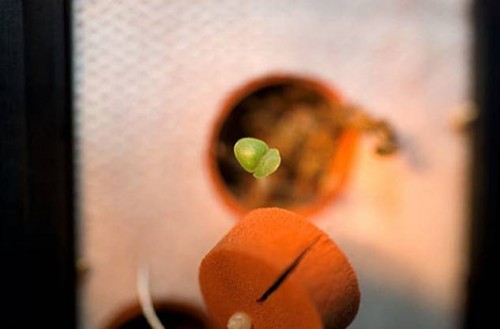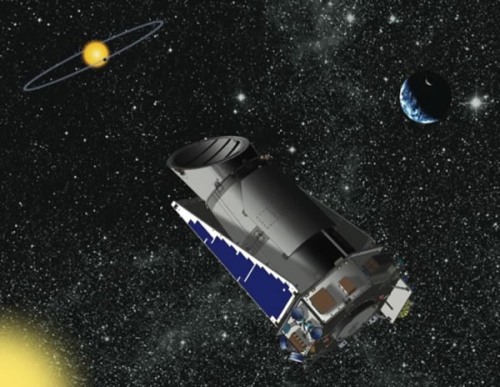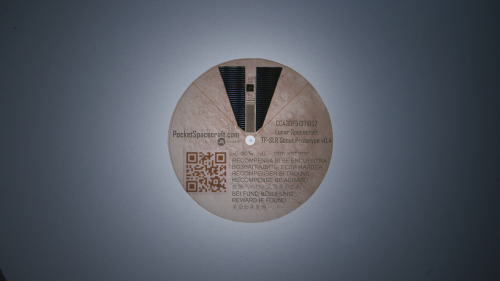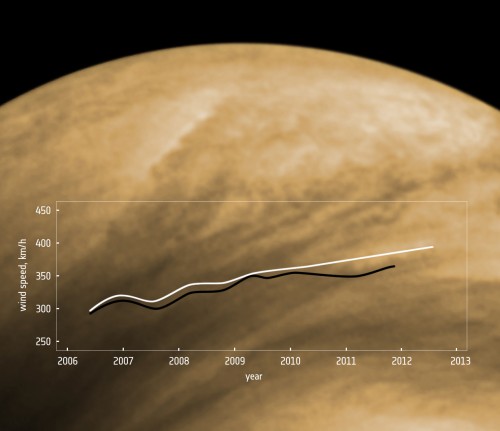Tag archives: space
Spacecraft duets, suprise supernovae, the dark side of physics and more
By Tushna Commissariat
While you would not actually be able to hear the uplifting notes of the music in the vast emptiness of space, a newly composed string and piano orchestral piece has unexpected ties to the cosmos. That’s because it is based on 36 years’ worth of data from NASA’s Voyager 1 and 2 spacecraft. Domenico Vicinanza, a trained musician with a PhD in physics who works at GÉANT, a European data-network company, says that he “wanted to compose a musical piece celebrating Voyager 1 and 2 together, so I used the same measurements (proton counts from the cosmic-ray detector over the last 37 years) from both spacecrafts, at the exactly same point in time, but at several billions of kilometres of distance [of] one from the other”. The result of this “data sonification” is a rather beautiful piece of music – one of the best examples of physics and the arts coming together that we have heard. Of course, the story garnered considerable interest…you can read more about on the Wired and Guardian websites.
View all posts by this author | View this author's profile
Cress on the Moon, more physics books, a radioactive ‘foot’ and more

A small green sprout of cinnamon basil, growing on board the International Space Station in 2007. (Courtesy: NASA)
By Tushna Commissariat
Early this week, a story in the Telegraph caught our eye – NASA is planning on sending turnip, cress and basil seeds to the Moon to germinate them! This is most definitely not the first time that plants have been grown beyond the realms of Earth. Indeed, potatoes were grown on board during a 1995 Space Shuttle mission and many experiments involving germinating seeds were done on the International Space Station. The goal of these studies was to understand the effects of microgravity on plant growth. But now, NASA plans to take this one step further in 2015 with their Moon Express mission, which will include the Lunar Plant Growth Chamber that will carry seeds and enough air and nutrients to allow the seeds to sprout and grow. Will fresh salad be on an astronaut’s menu soon?
Herschel in a minute
By Michael Banks
Here is an example of how to condense four years’ worth of space observations into just a minute.
The animation above, which was created by Pedro Gómez-Alvarez of the European Space Agency (ESA), shows a timeline of more than 37,000 scientific observations made by ESA’s Herschel Space Observatory.
The video runs from Herschel’s launch on 14 May 2009 until the infrared observatory made its last observation on 29 April 2013 as the craft’s detectors ran out of coolant.
Herschel – a far-infrared and submillimetre telescope – had two main goals: to study star formation in our galaxy; and galaxy formation across the universe.
Named after the German-born astronomer who in 1781 discovered Uranus, the probe carried a 3.5 m-diameter mirror – the largest to be deployed in space – and investigated light with wavelengths of 55–670 µm.
The craft was placed in an area of space some 1.5 million kilometres further out from the Sun beyond the Earth. Known as Lagrange point L2, it is where a space probe can usefully hover, little disturbed by stray signals from home and without having to use much fuel to keep it in position.
You can find some of the incredible images taken by Herschel at ESA’s multimedia gallery.
View all posts by this author | View this author's profile
Voyager 1: a peer-reviewed day to remember

Voyager 1 has left the solar system. (Courtesy: NASA/JPL-Caltech)
By Hamish Johnston
Yesterday a paper appeared in Science that makes the case that the Voyager 1 spacecraft has left the solar system. The response from the press and commenters has been to declare this a day to remember. Indeed, some have likened it to 20 July 1969 when Neil Armstrong first stepped on the Moon.
View all posts by this author | View this author's profile
Vintage snaps from space history
By James Dacey

1966 Lunar Orbiter picture of the Earth and Moon. (Courtesy: UCL)
If you look incredibly closely you may just be able to make out John Lennon’s flares or the England football team lifting the World Cup. This portrait of our planet from 1966 is part of the first collection of photos of the Earth taken from beyond the Moon. It was taken by a camera on board Lunar Orbiter I, the first US spacecraft to orbit the Moon, which helped pave the way for the Moon landings at the end of the decade.
View all posts by this author | View this author's profile
Kepler telescope goes into retirement…for now

Retirement among the stars: Artist’s concept of the Kepler spacecraft. (Courtesy: NASA/JPL-Caltech/Ball)
By Tushna Commissariat
A few months ago, I wrote a blog about NASA’s Kepler space telescope being in a spot of trouble, as the spacecraft shut down and went into “safe mode”. The problem was that two of the four gyroscope-like “reaction wheels” that help the telescope remain steady and pointed in a particular direction had broken. Since May, researchers have been looking at ways and means to fix the problem or work around it.
Unfortunately, after analysing and testing the systems, the Kepler Space Telescope team has decided to end its attempts to restore the spacecraft to full working order, and is now “considering what new science research it can carry out in its current condition”.
View all posts by this author | View this author's profile
Launch your own personalized lunar mission
By James Dacey

Photograph of a prototype Pocket Spacecraft: Thin-Film Scout
If you’re looking for a gift idea for a budding Buzz Aldrin then you might want to read on. A new crowd-funding initiative is offering the general public the chance to launch and control our own miniature missions to the Moon. Apparently, we are being given the chance to personalize our own “pocket spacecraft” that will hitch a ride on a commercial rocket before breaking free and spiralling down onto the lunar surface.
The project is the brainchild of some of the people behind the first space mission funded on KickStarter – a website that allows creative ventures to raise funds from the public. That initial project, called KickSat, offered people the chance to launch miniature satellites into the Earth’s atmosphere. It was a success and the mini satellites will be launched via a NASA mission later this year. This latest project is also being run through KickStarter and this time round we can send our space machines to the Moon.
View all posts by this author | View this author's profile
Winds are picking up on Venus

Faster and faster: average wind speeds at low latitudes on Venus. The white line shows data derived from manual cloud tracking; the black line is from digital tracking methods. (Courtesy: ESA)
By Hamish Johnston
Venus is a breezy planet. Planetary scientists have known for some time that its clouds zip along at hundreds of kilometres per hour – speeds on par with Earth’s high-velocity jet stream.
But now a team of researchers looking at data from the European Space Agency (ESA) Venus Express mission have noticed that the winds appear to have accelerated by about 33% over the past six years.
View all posts by this author | View this author's profile
60 Second Adventures in Astronomy
By Hamish Johnston
If you are a fan of astronomy and the comedian David Mitchell, the Open University has a treat for you. Mitchell and the OU have made a series of 12 short animated videos about the physics of the cosmos.
View all posts by this author | View this author's profile
Earth’s silent hitchhiker seen at last

This artist’s concept illustrates the first known Earth Trojan asteroid (Credit: Paul Wiegert, University of Western Ontario, Canada)
By Tushna Commissarat
Looks as if the Earth has a cohort – one that has been hitching a ride with our planet’s orbit for a while now. Astronomers sifting through data from NASA’s Wide-field Infrared Survey Explorer (WISE) mission have discovered the first known “Trojan” asteroid orbiting the Sun along with the Earth. It has been known since 1772 that stable small bodies can share the same orbit with a planet or a moon – as long as they remain at stable points in front of or behind the main body. Such Trojan asteroids have been found orbiting Jupiter, Mars, two of Saturn’s moons and Neptune, but had not been seen for the Earth until now. This is because they are difficult to detect, being relatively small and appearing near the Sun from the Earth’s point of view.
Trojans circle around “Lagrange points” – gravity wells where small objects can be relatively stable compared with two larger objects, in this case the Sun and the Earth. The points that the Earth’s Trojan – called 2010 TK7 – orbits around are known as the L4 and L5 points, and are 60° in front of and behind the Earth, respectively. As they constantly lead or follow in the same orbit as the planet, they can never collide with it; so you can breathe a sigh of relief if you were worried about a possible armageddon.
“These asteroids dwell mostly in the daylight, making them very hard to see,” says Martin Connors of Athabasca University, Canada, lead author of a paper about the discovery published in Nature. “But we finally found one, because the object has an unusual orbit that takes it farther away from the Sun than is typical for Trojans. WISE was a game-changer, giving us a point of view difficult to have at the Earth’s surface.”
The WISE telescope scanned the entire sky in the infrared from January 2010 to February this year. The researchers began looking for data for an Earth-bound Trojan using data from NEOWISE – a WISE mission that focused in part on near-Earth objects (NEOs), such as asteroids and comets. NEOs are bodies that pass within 45 million kilometres of Earth’s path around the Sun. The NEOWISE project observed more than 155,000 asteroids in the main belt between Mars and Jupiter, and more than 500 NEOs, discovering 132 that were previously unknown. The team found two Trojan candidates – of these, 2010 TK7 was confirmed as an Earth Trojan after follow-up observations were made using the Canada–France–Hawaii Telescope in Hawaii.
2010 TK7 is roughly 300 metres in diameter, at a distance of about 80 million kilometres from Earth. It has an unusual orbit that traces a complex motion near the Lagrange points in the plane of the Earth’s orbit, although it also moves above and below the plane. The asteroid’s orbit is well defined and remains stable for at least 10,000 years. For the next 100 years, it will not come closer to the Earth than 24 million kilometres (by angela). An animation, with a Star Wars worthy soundtrack, showing the orbit can be found below. (Image and video credit: Paul Wiegert, University of Western Ontario, Canada.)
A handful of other asteroids also have orbits similar to Earth. Such objects could make excellent candidates for future robotic or human exploration. Unfortunately, asteroid 2010 TK7 has not been deemed worthy of exploration because it travels too far above and below the plane of Earth’s orbit, and so would require a large amount of fuel to reach it.
View all posts by this author | View this author's profile